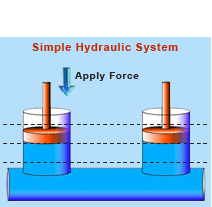
Hydraulicoil is a fluid lubricant used in hydraulic systems for transmitting power. Pascal's law is the basis of hydraulic drive systems.
In the physical sciences, Pascal's law or Pascal's principle states that "a change in the pressure of an enclosed incompressible fluid is conveyed undiminished to every part of the fluid and to the surfaces of its container.
Pascal's law can be interpreted as saying that any change in pressure applied at any given point of the fluid is transmitted undiminished throughout the fluid.
The basic idea behind any hydraulic system is very simple:
Force that is applied at one point is transmitted to another point using an incompressible fluid.
As the pressure in the system is the same, the force that the fluid gives to the surroundings is therefore equal to pressure x area. In such a way, a small piston feels a small force and a large piston feels a large force.
The force is almost always multiplied in the process. The picture below shows the simplest possible hydraulic system: Simple Hydrulic System
If you apply a downward force to one piston, then the force is transmitted to the second piston through the oil in the pipe. Since oil is incompressible, the efficiency is very good -- almost all of the applied force appears at the second piston.
The pipe connecting the two cylinders can be any length and shape, allowing it to sneak through all sorts of things separating the two pistons. The pipe can also fork, so that one master cylinder can drive more than one slave cylinder if desired.
The brakes in car is a good example of a basic piston-driven hydraulic system. When the brake pedal is pressed , it pushes the piston in the brake's master cylinder. The slave piston, at the wheels, actuate to press the brake pads against the brake rotor to stop the car.
It is important that a hydraulic system contains no air bubbles. If there is an air bubble in the system, then the force applied to the first piston gets used compressing the air in the bubble rather than moving the second piston, which has a big effect on the efficiency of the system.
Common hydraulic system consists of:Oil tank;Hydraulic pump;Oil filter;Control valves;Pistons and Pipes.
Hydraulic systems are widely used in industrial machinery, construction equipment, automotive, aircraft and marine applications.
One of the most important criteria in the selection of a hydraulic fluid is viscosity. There is a common misconception that reducing hydraulic fluid viscosity will decrease operating temperatures, when in fact higher viscosities may lead to a reduction in operating temperatures in hydraulic applications. This is because a hydraulic fluid that is too low in viscosity will reduce the volumetric efficiency of pumps and cause fluid overheating. In addition, low viscosity fluids can lead to increased friction and pump wear. A fluid that is too high in viscosity, on the other hand, will cause poor mechanical efficiency, startup issues and wear due to cavitations. Therefore, selecting the proper fluid involves optimizing oil viscosity in terms of volumetric and mechanical pump efficiency. To accomplish this, the requirements of the hydraulic components, as well as the operating temperature range, must be taken into consideration.
International Standardization Organization (ISO) has established a viscosity grading (VG) system for industrial hydraulic oils. According to the system hydraulic oils are designated by the letters ISO followed by a number equal to the oil viscosity measured in centistokes at 40°C (104°F) viz. ISO VG: 32, 46,68 etc.
Hydraulic fluid must meet standards that are set by the OEM. It may also meet the standards set by IS/ DIN/ US Steel/ Denison/ Cincinnati Milacron/ Vickers etc.